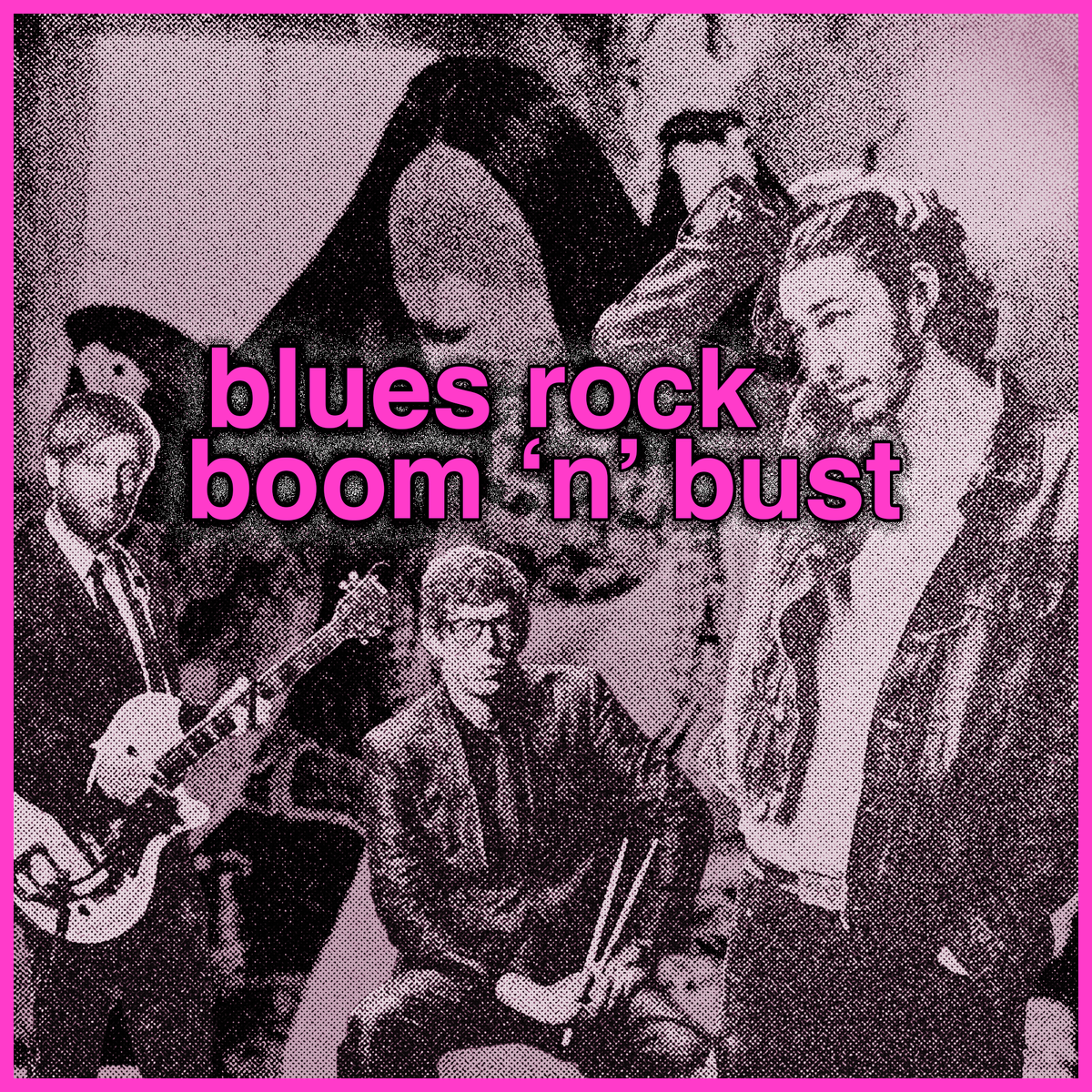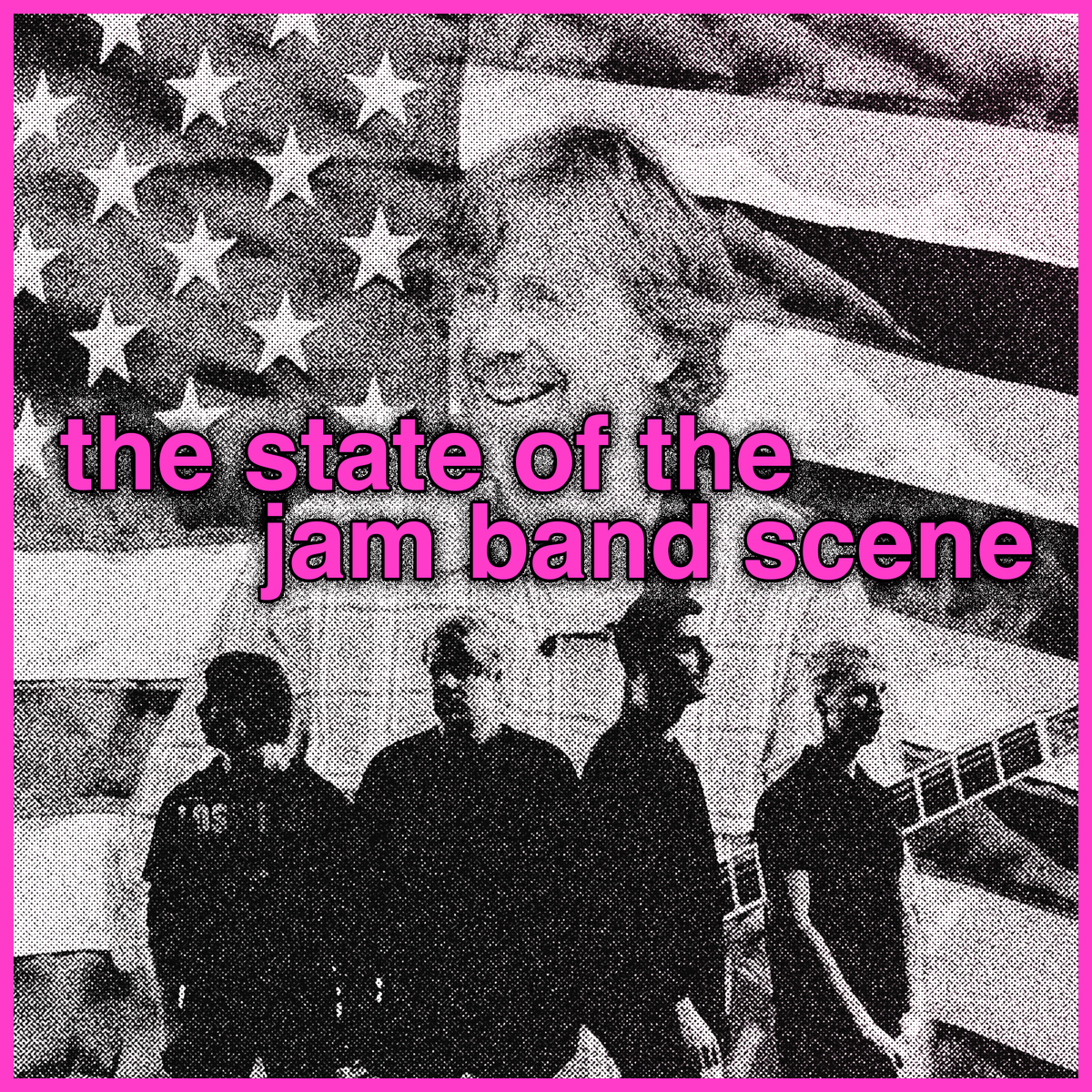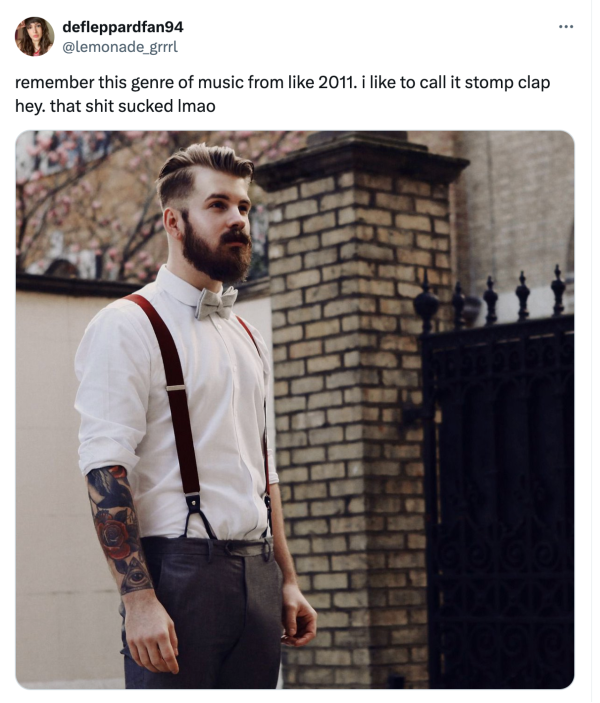blues rock boom 'n' bust

A growing 'content vertical' on I Enjoy Music seems to be deep dives on music moments / trends / communities from people who have spent plenty of time in the trenches—like this big report on jam bands (and the internet conversations surrounding them) by Jerry Koenigsmark:

Let's do it again! Today we have a guest post about the 2010s blues rock explosion—its origins, imperial period, fall from grace and possible 2024 revival—from Harlan Talib Ockey. Is there any gold left on blues rock's ceiling? Or is its re-emergence Too Sweet to last? Let's learn...
Take Me Back to Church: The Rise, Fall, and Rise of 2010s Blues Rock
An I Enjoy Music Guest Post by Harlan Talib Ockey
I first realized something had shifted while I was watching the Tokyo Olympics". Khrystyna Pohranychna, a Ukrainian rhythmic gymnast, performed a strutting, rock-inspired hoop routine to Kaleo’s “No Good."
Just a few years previously, the song choice might have seemed shockingly cutting-edge for such a regimented sport. But by 2021, the world had changed: Pohranychna was dancing for an empty stadium, and Kaleo’s whole subgenre was dead.
From around 2009 to 2016, there was a boom of blues rock into the (relative) mainstream. These artists were regularly topping the Billboard Hot 100 album charts. Grammy nominations were handed out like candy. Even a few established acts tried adopting the sound. Then, suddenly, it crashed. Acts broke up, went on hiatus, started getting poor reviews.
This year, however, something has changed. Blues rock is crawling back up the charts. After a full decade, Hozier secured his second major hit — and first US #1. Newer artists like Teddy Swims have now vaulted into the top ten. Arguably, there are signs that this subgenre is about to become even more successful than it was the first time around.
Whenever I need to explain the Early 2010s Blues Rock Boom, I just point to Alabama Shakes and Hozier. The former was nominated for the Album of the Year Grammy and scraped the top of the Billboard album charts twice, which is objectively remarkable for a two-album career. The latter had easily the highest-charting hit of this era. “Take Me to Church” reached #2.
This type of blues rock has always existed in some form. There are songs by early electric blues artists like Otis Rush that can be pointed to as forerunners of this style, with their blocky, distorted guitars and flexible vocals. Other chunks of the subgenre are descendents of the languid, droning guitar of hill country blues acts like Junior Kimbrough. Or from the morbid side of 1950s rhythm & blues. Still more were influenced by Jimi Hendrix, The Gun Club’s blues punk, or ‘90s desert rock. A savvy Blues Rock Boom artist could combine all these ingredients.
Blues Rock Rising
In the early 2000s, the White Stripes happened. They didn’t necessarily birth the Blues Rock Boom sound — it’s hard to think of an artist who aspired to Jack White’s countertenor howl, or his punk-infused musings on Citizen Kane — but they are likely the best-known modern blues rock band, and proved a market existed for the genre. Records like Elephant (2003) are commonly cited among the best of this century, or even the best of all time.
Finally, as the sun set on the 2000s and the White Stripes faded into retirement, a new cadre of artists would pick up their guitars and take the Blues Rock Boom into the mainstream.
The first act to do this that I would confidently identify as part of the Early 2010s Blues Rock Boom was Cage the Elephant. “Ain’t No Rest for the Wicked” was released as their third ever single in June 2008, but kept climbing for over a year. It charted first in the UK (right above Taio Cruz and Nickelback) and then, after a 2009 re-release in the US, sat in the lower quarter of the Hot 100 for eleven weeks.
The second—and ultimately the more consequential one—was the Black Keys. While they’d been releasing records since 2002, their grand commercial breakthrough was in 2010, with Brothers. “Tighten Up," the album’s lead single, ended up being their first entry on the Hot 100. The album won three Grammys. Their 2011 followup, El Camino, did too.
From there, it was off to the races. Alabama Shakes. Royal Blood. Hozier. Gary Clark Jr. Arctic Monkeys adopted the sound with the soul and blues-infused record AM, which became their best-selling album to date.
Rival Sons. Kaleo. Fantastic Negrito. Benjamin Booker. JD McPherson. More, more, more.
Blues Rock Big Business
In the wake of Oppenheimer, I’ve been trying to watch Peaky Blinders. The show was perhaps Cillian Murphy’s second big breakthrough, after 28 Days Later, and debuted in 2013. I’ve only made it through the first season so far, probably because I keep being waylaid by something that is incredibly 2013: its soundtrack. The music featured on the show is almost always blues rock of some kind. It’s not all cutting-edge Early 2010s Blues Rock Boom, but it does include, for instance, Royal Blood and the Black Keys’ Dan Auerbach. Jack White and his many projects are probably the most frequently included artists. (Okay, I haven’t calculated this, but at least three of his songs are spotlighted in the first season.)
Peaky Blinders also foregrounds its soundtrack more than most shows. For one, it’s anachronistic. Paste’s Fletcher Peters argues that the use of modern songs in period pieces helps bring the viewer closer to the action, making characters who lived hundreds of years ago more human and relatable. Peaky Blinders takes place shortly after World War I. By incorporating music from the recent past, the characters appeared modern and visceral. And it had the byproduct of associating the Blues Rock Boom with a kind of edgy, criminal cool.
In fact, one of the main ways this subgenre spread was through popular culture. “Ain’t No Rest for the Wicked” was prominently featured in the 2011 video game Borderlands. The Black Keys’ “Howlin’ For You” and “Gold On the Ceiling” served as goal songs for the Arizona Coyotes and Nashville Predators, respectively. Kaleo managed to bridge both the gamers and the sports kids: tracks from their album A/B were included in FIFA 16, Madden NFL 17, and NHL 18.
Possibly the last major TV show to heavily use the Blues Rock Boom on its soundtrack was Vinyl, an HBO show about the 1970s music industry helmed by, among others, Martin Scorsese. Like Peaky Blinders, it included songs from Royal Blood and Kaleo. Vinyl premiered in 2016, and also saw its last episode air the same year. (The show was canceled due to low viewing numbers.) I can’t say if it’s worth watching, but 2016 was likely the last good year for this subgenre anyway.
A curious thing about Kaleo is that they were very clearly influenced by other Blues Rock Boom artists. “Hot Blood”—which appeared in NHL 18—could easily slot in on the Black Keys’ El Camino. In a review of A/B, Kaleo's 2016 major label debut, The Guardian’s Kate Hutchinson wrote that their sound was a pale imitation of the Black Keys, James Bay, and Kings of Leon. The latter two aren’t Blues Rock Boom artists, but as the genre reached its saturation point, its later generation of artists sounded like they had absorbed their ideas about the blues from rock and blues rock, rather than the blues itself. Kaleo hails from a town of 13,000 just outside Reykjavik, Iceland. On “Broken Bones,” they sing about “deep Texas, Mississippi state” — places they had only known through the internet before signing a record deal and moving to Austin.
There’s a case to be made that Kaleo represents a natural endpoint to the Blues Rock Boom. They were popular, yes. But in the same way that artificial intelligence models tend to produce gibberish when trained on other AI-generated text, the subgenre had begun to cannibalize itself. Blues rock's spectrum of influences increasingly collapsed into a single Blues Rock Boom sound, taking little inspiration from artists outside its echo chamber.
Blues Rock Bankruptcy
In 2016, the subgenre’s most successful acts also stopped releasing albums. Alabama Shakes went on an indefinite hiatus after their second record, 2015’s Sound & Color, and didn’t re-emerge in any form until frontwoman Brittany Howard dropped her 2019 solo debut. Hozier’s sophomore album was released in 2018, four years after his first. Royal Blood also took the years 2015 to 2017 off from new music, as did the Black Keys and Jack White. (Or 2016 to 2018, in Gary Clark Jr.’s case.) Arctic Monkeys returned in 2018 with Tranquility Base Hotel & Casino, which sounded almost nothing like AM.
Four years away and a little stagnation might not usually be enough to kill a subgenre, but around 2016, the sound of pop started to change. In the early 2010s, the charts had grown friendly to the rootsier side of rock and folk. This was the era Mumford & Sons were consistently notching hits. The era of “Ho Hey” and “Budapest”. “Stomp clap hey," if you will.

Trap had first reached the mainstream in the early 2000s, but it would soon become the defining sound of popular music in the late 2010s. Producers like Lex Luger and Metro Boomin helped build trap into a juggernaut in the first half of the decade, and then a burst of major hits brought it to pop music’s attention. Fetty Wap’s “Trap Queen” was possibly the genre’s biggest mainstream crossover moment as a sleeper hit in 2015, followed by the one-two punch of Desiigner’s “Panda” and Rae Sremmurd’s “Black Beatles” the next year. These songs reached #2, #1, and #1 on the Hot 100, respectively, moving trap from the top of the rap charts to the top of the charts.
By 2018, nothing in the American top ten would vaguely resemble rock or folk, unless you count Ed Sheeran’s pop era or Imagine Dragons. Even pop itself had jumped aboard the trap phenomenon; this was the year of Ariana Grande’s “God Is a Woman," after all, with its impossibly fast hi-hats and triplet flow.
Blues Rock Boom artists that took the midpoint of the decade off returned to a very different landscape in popular music. Several Blues Rock Boom comeback albums received, in Wikipedia’s parlance, mixed reviews. Pitchfork’s Sam Sodomsky panned Hozier’s followup, writing “Nearly every element of “Take Me to Church” is isolated and recycled here." None of its singles made the Hot 100. Both good and bad reviews of Royal Blood’s second effort noted they were on “familiar ground." The same happened with the Black Keys’ Let’s Rock (2019) — “cribs so overtly from their influences” (good review), “doesn’t inspire much in the way of excitement” (bad).
The most telling followup flop is perhaps from Kaleo. Surface Sounds, their sequel to A/B, was initially set to be released in 2020, but got delayed almost a year due to the pandemic. None of Surface Sounds’ five singles charted outside of Iceland. The record’s peak on the Billboard 200 album charts was #102, 86 places below A/B. A/B was on the album charts for 36 weeks, while Surface Sounds was there for just one. As far as I can find, no English-language outlets reviewed the album.
So by the time I heard Kaleo’s “No Good” in Khrystyna Pohranychna's gymnastics routine, it was easy to recognize that nothing like it had done well for several years. For the first time, it occurred to me that this had been a distinct era and subgenre, and that it was already dead.
Blues Rock Remedy
It seems to have surprised a lot of people that Hozier's “Take Me to Church” never reached #1. It did make it to the top in some countries, including Sweden and Italy, but not in the United States. Or in the country I lived in at the time, New Zealand—which really does sound fake, because it was at one point so ubiquitous that seemingly my entire high school knew the words.
I discovered this fact (along with r/popheads) earlier this year, when Hozier notched his first #1 hit. That song, “Too Sweet," was released as part of a set of bonus tracks from his 2023 album Unreal Unearth. Conveniently, it happens to be textbook Blues Rock Boom. Much of Hozier’s recent work has been acoustic guitar or keys-driven—the electric guitar’s usually been more texture than topline, especially on singles. The fact that “Too Sweet” wasn’t even originally on the album speaks to this. But with its driving bassline and thick, reverb-y electric guitar chords, “Too Sweet” is a sibling of his 2014 Blues Rock Boom singles like “Someone New."
“Too Sweet” was, in retrospect, a song that came along at the perfect time. Hozier has always had a strong core fanbase — “Eat Your Young," his first single from 2023’s Unreal Unearth, made it up to #67 last year thanks to rock-solid streaming numbers. The following tour immediately sold out. (Which I can personally attest to, having tried and failed to get tickets.) Next, a collaboration with a buzzy folk artist — we’ll dig into him in a second — peaked at #37 at the end of last year. Lastly, TikTok. Any catchy song with lyrics comparing two things is catnip for the platform, and TikTokers pounced on “Too Sweet” before it was even officially released as a single.
But does this explain everything?
Another major point to note: roots music is now very popular. In 2023, country music streams rose by 23.7% over the previous year. And that was before massive pop names like Beyoncé, Lana Del Rey, and Post Malone either went or promised to go country in 2024. (ed. note—Lasso, where are you???) Even as a deeply American genre, country has made major inroads into pop music in nations like the U.K. (Here’s Dua Lipa duetting with country star Chris Stapleton at the Academy of Country Music Awards.) The top two songs on the Hot 100 as I write this are both country: Shaboozey’s “A Bar Song (Tipsy)” and Post Malone/Morgan Wallen’s “I Had Some Help."
Slate’s Carl Wilson proposes a number of theories for why country is having such a mainstream moment. The fight for racial and gender inclusivity against the Nashville establishment, country listeners adopting streaming during the pandemic, and a lack of new trends in pop and rap all seem to have played a part. And an interest in rootsy authenticity, or hiding in the woods.
On the back of this concept, newer folk acts reminiscent of Mumford & Sons or the Lumineers have surged to mainstream popularity again. The most prominent is Noah Kahan, a New England singer-songwriter who was nominated for the Best New Artist Grammy earlier this year. Kahan first found fame by going viral on TikTok, and then hit the stratosphere with the latter singles from his 2022 album Stick Season. “Dial Drunk," a bonus track soon reworked to add Post Malone, climbed up to #25 on the Hot 100 in the summer of 2023. Then Stick Season’s title track, an earlier single, entered the charts and peaked at #9. Since then, Kahan has logged hits with Zach Bryan, Kelsea Ballerini, and Kacey Musgraves, all critically acclaimed country stars. And with Hozier, shortly before the release of “Too Sweet”.
There’s also a new kind of nostalgia emerging in certain places on the internet. In about 2021, teens started posting TikTok videos with captions like “I wish I was 16-18 during 2014,” paired with images of One Direction or Arctic Monkeys-era Tumblr. During the pandemic, nostalgia for Tumblr’s early 2010s aesthetic began infecting the site's modern-day community, as they yearned for a time with a little more stability.
Much ink has been spilled over the last two years claiming we’re having an “indie sleaze” revival, too. “Indie sleaze” is a name that no one used at the time for, essentially, the 2000s to early ‘10s rock and alt-pop scenes, including both its music and its fashion. Several Blues Rock Boom precipitators like the White Stripes and the Kills are credited with defining the aesthetic, as well as AM’s muse Alexa Chung.
All of this has created an exceptional environment for the Blues Rock Boom sound to re-emerge. Last August, Teddy Swims’ "Lose Control" debuted on the charts at #99 and climbed all the way up to hit #1 in March. “Lose Control," a bluesy ballad with warped keys and a soaring slide guitar solo, sounds like an outtake from the Black Keys’ Turn Blue (2014). Benson Boone’s "Beautiful Things," a folk-influenced dirge that turns into a Royal Blood song halfway through, rocketed to #2 earlier this year. Both “Lose Control” and “Beautiful Things” were boosted heavily by TikTok.
Blues Rock Recovery?
By commercial metrics, the Blues Rock Boom sound is not only back, but more successful than the first time around. It should be heartening for the subgenre’s fans that both Teddy Swims and Benson Boone are newer artists with only one studio album each. These aren’t legacy acts that might be buoyed up the charts simply by nostalgia for their glory days. While Hozier has an established fanbase, he’s never had a large mainstream following. This could imply that the sound now has a long-term future.
But this also might be a relative blip. For one thing, it’s extraordinarily recent: nothing from this subgenre was represented in the top ten in 2023. “Lose Control," “Too Sweet,” and “Beautiful Things” all peaked on the charts between March and April. Even the country and folk surges precipitating this are remarkably new. 2023 saw four #1 hits from male country singers, breaking a 42-year drought of zero #1s for solo male country acts.
It’s worth noting how the Blues Rock Boom collapsed the first time. The trends holding it aloft, like “stomp clap hey," dissipated. The sound of popular music changes constantly, and just as country vaulted onto the charts with little warning last year, it will—at some currently unknown point—leave them.
The question of whether the sound will continue to evolve is less easy to answer. We’re still so early into the Blues Rock Boom Revival that our sample size of hits is three. Maybe even two and a half. Teddy Swims and Benson Boone would have been considered forward-thinking ten years ago, but today, it can be hard to tell if they’re invested in pushing this subgenre further or just imitating those who did.
Yet as someone who was a die-hard fan of the Blues Rock Boom all those years ago, these are genuinely exciting times. Many short-lived movements never get a second chance. I hope these newer artists make it count.
Harlan Talib Ockey is a music writer/reporter based in Melbourne, Australia. He has a website, a Twitter account, and a newsletter called Streaming Disservice.
Thanks for reading I Enjoy Music! If you like it, tell a friend. If you really like it, buy the first PDF in the I Enjoy Music DUETS series!







